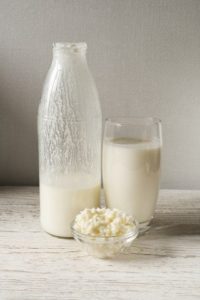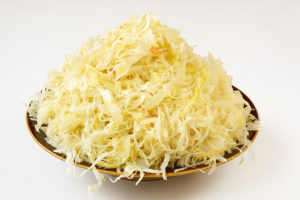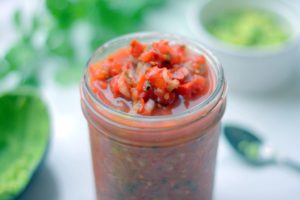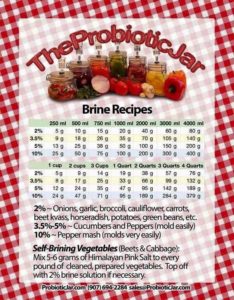I began culturing and fermenting foods because of an illness that caused havoc to my gut health. Too many antibiotics and steroids left me weak, tired, and vulnerable to colds, flu, and other lurking viruses wanting to invade. I am not a doctor or health professional. These are my personal recipes and experience with them. For more information ask your health care team and join a fermenting or food culture group.
I had made yogurt many times, but wanted to increase the types of good bacteria introduced into my system. I’m going to share three of my favorite cultures and ferments.
1- Milk kefir is produced by adding grains (small bacterial colonies that resemble cauliflower.) You can order milk kefir grains online or ask another kefir user to share. I use about 2 tablespoons with a quart of whole milk. Pour milk over grains into a 1 to 1 1/2 quart jar. I use wide mouth canning jars. Cover jar with a clean cotton cloth or a bleached coffee filter (no lid) and let set at room temperature for 15-24 hours. You will see little pockets of liquid (whey) separating from milk on the sides of the jar. This is the first ferment. At this time, I gently stir the kefir with a wooden spoon then pour through a plastic or stainless steel strainer catching my grains. Put the grains in a pint jar with 1/4 cup of your newly cultured milk and add 1/2-1 cup fresh milk. Put a lid on them and store in the refrigerator until next use. I use mine 2-3 times a week. Now I pour my kefir milk that was strained into a 1qt jug and keep in the refrigerator for 24 hours before drinking. This is your second ferment. During this time you can add fresh fruit like mashed bananas, strawberries, etc. I drink mine plain. It will have a sour taste but not spoiled. My granddaughter calls it her lemon milk. It may also have a slight fizz.
2- Sauerkraut is a fermented cabbage dish. I cut a whole head of cabbage into thin strips and massage salt into it in layers. Cut cabbage up, put a layer in a large bowl, sprinkle salt over the layer and massage with clean hands, some people pound it as you’re trying to release the water from the cabbage which creates the brine (sea salt, pink salt, or mineral salt seems to work best). Keep adding layers until cabbage is used up. I usually layer three to for times. After layering, massage or pound cabbage every 15 minutes for an hour or two until brine covers the cabbage. If your cabbage doesn’t make enough brine, boil 1 cup of water then add 3/4 teaspoon of salt. Stir, let cool to room temp and pour enough over cabbage to slightly cover. I then divide the cabbage mix between 2 one quart jars, smash down, place a fresh cabbage leaf on top to hold all pieces under brine and weight the top with a shot glass and rock, stone, or whatever I have handy. This keeps all the cabbage under the brine. Cover with a cotton towel. I’m including a brine chart. The kraut needs a 2-2 1/2% brine. Let your cabbage ferment for 4-6 weeks. Take cover off and remove shot glass and weights. Put plastic lid or place wax paper between jar and canning lid to prevent rust. Refrigerate, and stir and push kraut under brine after each serving. If mold ever develops, throw the whole batch out. I joined a fermenting group to learn how to care for long term ferments.
3- Salsa or onions are my favorite 2 veggie ferments and are super easy! Onions need to be sliced, I love using red onions. Fill a quart jar with red sliced onions, pour a 2-2 1/2% brine over. Cover with a cotton cloth or unbleached coffee filter, I gently stir mine each day and push onions under the brine, then put your cover back on. Mine are ready to refrigerate in 3 days. Take cover off and put a plastic lid on the jar or put wax paper between the jar and the lid to prevent metal lid from rusting. I begin using them around the 1 week mark.
Salsa is a great topping for many things from eggs, to meat or potatoes. I use organic veggies. My basic recipe is 5-6 Roma tomatoes diced small, 3 cloves chopped garlic, 1/2 medium onion finely chopped, 1-2 small jalapeños seeded and inner white membrane removed. I use a 3 1/2-5% brine. Ferment like onions on counter. After 3 days store in refrigerator the same as onions. I season with a bit of chili powder and cilantro when serving. I don’t add them because spices tend to float and may cause molding which will ruin the batch.
Note: When adding cultures and ferments to your diet do so slowly. One new food at a time in small amounts. If you only want to do one, my suggestion would be milk kefir as it has a great variety of bacterial strains. Start with a tablespoon in the morning and gradually increase.
By Valerie Thrap Ross





Leave a Reply
You must be logged in to post a comment.